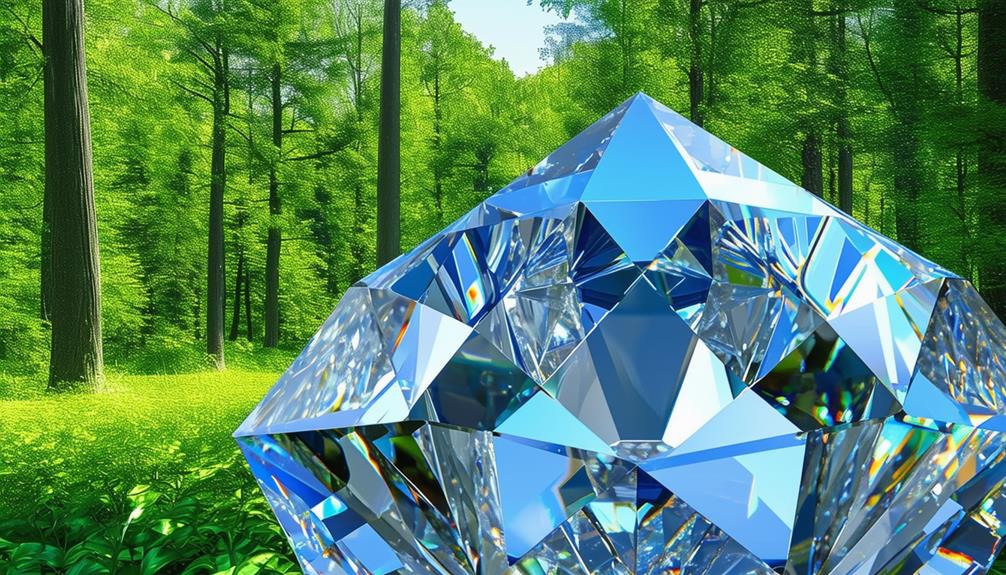Article Contents
Choosing synthetic diamonds significantly contributes to environmental sustainability. These gems, created in laboratories, have a reduced ecological footprint compared to traditionally mined diamonds, which often cause extensive land degradation and biodiversity loss.
The process of creating synthetic diamonds also requires less water and energy, helping to conserve these crucial resources and support healthier ecosystems. By opting for synthetic diamonds, consumers demonstrate a commitment to ethical purchasing and environmental conservation, aligning their personal values with actions that support planetary health.
Further investigation into their production confirms the sustainable benefits of synthetic diamonds.
Key Points
- Synthetic diamonds significantly reduce ecological impact by avoiding extensive habitat destruction and soil excavation associated with traditional diamond mining.
- These lab-grown diamonds aid in preserving biodiversity and water resources, thereby enhancing environmental sustainability.
- The production of lab-created diamonds generally requires less energy and water, contributing to a reduced carbon footprint.
- The manufacturing process of synthetic diamonds adheres to strict environmental regulations, ensuring responsible sourcing and production.
- Opting for synthetic diamonds promotes sustainable practices and supports ethical consumer choices.
Eco-Friendly Diamond Production
Lab-created diamonds offer an environmentally friendly alternative to traditional diamond mining, significantly reducing the ecological footprint associated with gem production. These diamonds are crafted in controlled settings, using advanced technology that ensures they possess the same aesthetic and physical characteristics as naturally mined diamonds but with far less environmental impact.
The process of creating lab-grown diamonds adheres to stringent environmental standards at every stage, from sourcing materials to final production. This approach is a stark contrast to the ecologically damaging methods often associated with traditional diamond mining. As such, lab-grown diamonds represent a sustainable and responsible choice in jewellery.
Opting for lab-created diamonds supports sustainable practices and contributes to a more environmentally conscious future. By choosing these gems, consumers can enjoy beautiful jewellery while also making a positive impact on the environment, breaking away from the harmful practices of conventional diamond sourcing.
Reducing Habitat Destruction
Choosing synthetic diamonds is a crucial measure for sustainable luxury, as it helps reduce habitat destruction. These lab-created gems minimise land disruption, preserving the earth's surface and its diverse ecosystems, thus maintaining biodiversity.
Furthermore, synthetic diamond production conserves water resources by avoiding the high water consumption associated with traditional diamond mining.
Minimising Land Disruption
Synthetic diamonds significantly reduce environmental degradation by minimising the need for the extensive land excavation and deforestation that traditional diamond mining necessitates. Choosing lab-grown diamonds promotes sustainable practices that reduce the impact on Earth's ecosystems. This choice not only benefits the environment but also appeals to those seeking alternatives to the detrimental effects associated with conventional mining.
| Aspect | Traditional Mining | Synthetic Diamonds |
|---|---|---|
| Land Excavation | Extensive | Minimal |
| Habitat Impact | High | Low |
| Ecosystem Disruption | Significant | Negligible |
| Consumer Choice | Limited | Expanded |
| Sustainability | Low | High |
Opting for synthetic diamonds is a proactive step towards ecological conservation, reflecting a dedication to environmental stewardship and technological advancement.
Preserving Biodiversity
Choosing synthetic diamonds is a crucial step in preserving biodiversity. Traditional diamond mining often leads to significant habitat destruction, but synthetic diamonds are produced in labs without harming natural environments.
This choice supports environmental stewardship and wildlife protection, contributing to the conservation of ecosystems that many species rely on for survival. By opting for lab-created diamonds, consumers demonstrate a commitment to sustainable practices and help maintain ecological balance by avoiding the invasive mining that harms both land and water habitats.
Ultimately, selecting synthetic diamonds aligns with a broader goal of environmental respect and protecting the planet's diverse biological resources.
Sustaining Water Resources
Building on the theme of environmental protection, choosing lab-created diamonds significantly aids in the preservation of water resources. This choice supports the sustainability of diamonds while promoting water conservation and protecting vital ecosystems.
- Water Conservation: The production of synthetic diamonds does not require the water-intensive processes associated with traditional mining, thus conserving valuable water reserves.
- Ecosystem Protection: Synthetic diamonds circumvent the need for conventional mining, which typically leads to water pollution and habitat degradation. This avoidance helps maintain the integrity of both aquatic and terrestrial ecosystems.
- Ethical Choices: Selecting lab-created diamonds demonstrates a commitment to ethical consumerism, emphasising the importance of conserving natural resources and protecting environmental health.
Reduce energy and water consumption
Focusing on the production of synthetic diamonds, it's clear that these gems are not only visually appealing but also a step forward in sustainable practices.
The methods used to produce them significantly reduce energy and water consumption, demonstrating a commitment to environmental protection.
Reduced Mining Impact
Synthetic diamonds significantly reduce the environmental impact of diamond acquisition by using substantially less energy and water than mined diamonds. Opting for synthetic diamonds supports ethical sourcing practices and contributes to a smaller carbon footprint, reflecting a commitment to environmental conservation and personal accountability.
- Energy Efficiency: Synthetic diamonds are produced using approximately 250 million BTUs per carat, which is significantly lower than the energy required for mining natural diamonds.
- Water Conservation: The production of synthetic diamonds requires minimal water usage, demonstrating a dedication to sustainable practices.
- Reduced Land Disruption: Synthetic diamond production does not involve extensive land excavation, thereby preserving natural landscapes and biodiversity.
Efficient Production Processes
The production of synthetic diamonds utilises advanced technologies to significantly enhance efficiency in energy and water usage. These laboratories consume 1.5 times less energy compared to traditional diamond mining, resulting in a 40% reduction in carbon emissions. Such advancements align with sustainable manufacturing principles, leading to a smaller environmental footprint.
Additionally, these facilities minimise land disturbance and implement water recycling, demonstrating a strong commitment to environmental stewardship. These practices not only conserve vital resources but also sustain the luxury of choice for future generations, ensuring sustainable luxury remains accessible.
Conservation of Water Resources
Synthetic diamonds significantly reduce water usage during production, presenting a more sustainable option compared to traditional diamond mining. This approach not only conserves vital water resources but also emphasizes the environmental advantages of choosing lab-grown diamonds. By selecting synthetic diamonds, consumers actively support water conservation and promote ecological sustainability.
- Efficient Water Utilisation: Laboratory methods for creating diamonds require less water, thus protecting water bodies and ecosystems.
- Advocacy for Eco-Friendly Practices: Opting for synthetic diamonds supports businesses that are committed to environmental sustainability.
- Impact on Water Conservation: Purchasing synthetic diamonds helps decrease the overall water footprint of the jewellery industry.
Choosing synthetic diamonds advocates for a balanced coexistence of luxury and environmental responsibility.
Minimal Pollution Output
Lab-grown diamonds are made with significantly less environmental impact compared to traditional mining, providing a sustainable option. These man-made diamonds are created using advanced technologies that focus on minimal emissions and avoiding major ecological disruption, representing a significant step forward in environmentally friendly gemstone production.
The process of producing synthetic diamonds results in minimal waste, which is a stark contrast to the significant environmental harm caused by conventional diamond mining, including widespread soil and water pollution. Manufactured in controlled environments, lab-created diamonds reduce the use of hazardous substances, thus helping to safeguard air and water quality. Opting for synthetic diamonds promotes environmental sustainability and reduces ecological harm.
Supporting Biodiversity Conservation

Choosing synthetic diamonds significantly contributes to biodiversity preservation by reducing the need for environmentally damaging mining practices that destroy natural habitats. This choice not only demonstrates a commitment to environmental responsibility but also supports the protection of wildlife and ecosystems. Consumers who select lab-created diamonds play an active role in conserving biodiversity, ensuring the survival of various species in their natural environments.
- Ecosystem Integrity: Synthetic diamonds help maintain natural habitats, preserving the balance vital for the health of ecosystems.
- Wildlife Protection: By avoiding traditional mining, this choice helps prevent the endangerment of various species, thus supporting biodiversity.
- Conservation Support: Opting for synthetic diamonds supports global efforts aimed at preserving natural habitats.
Choosing synthetic diamonds transcends aesthetic value; it represents a decision to support a sustainable future where nature is not compromised by human activities. This choice not only helps protect the natural beauty of our world but also secures a biodiverse, healthy planet for future generations. By favouring synthetic diamonds, consumers influence significant environmental outcomes, advocating for a cause that goes beyond mere beauty to include the overall health and sustainability of our planet.
Advancing Sustainable Practices
The production of synthetic diamonds significantly reduces the environmental damage typically associated with traditional diamond mining. By using eco-friendly manufacturing techniques, this industry helps to protect our planet's ecosystems and vital resources. These methods not only cut carbon emissions but also support extensive environmental conservation efforts.
Opting for synthetic diamonds shows a dedication to ethical practices, distancing consumers from the environmental and ethical concerns linked to natural diamond extraction. This decision promotes a market that prioritises sustainability and ethical responsibility.
Moreover, advancements in synthetic diamond production have greatly lowered energy consumption and waste generation. This transition aligns with global efforts to tackle climate change and sets a new standard for the gemstone industry. It marks a significant move towards more responsible consumption and production practices, offering hope for environmental sustainability.
Choosing synthetic diamonds means selecting a symbol of beauty that also supports environmental conservation. This choice demonstrates a profound respect for nature and makes a positive contribution to the sustainability of our planet for future generations.
Commonly Asked Questions
Are Synthetic Diamonds Better for the Environment?
Synthetic diamonds significantly reduce the environmental impacts linked to conventional diamond mining, like habitat destruction and soil erosion, as well as decreasing the carbon emissions generated during the extraction process. By opting for synthetic diamonds, consumers can endorse more environmentally friendly practices that help to preserve the environment. This decision demonstrates a dedication to sustainability and responsible management of natural resources.
What are 3 benefits of having synthetic diamonds?
Synthetic diamonds offer significant benefits in the jewellery industry by being cost-effective, environmentally friendly, and versatile without sacrificing quality. These lab-grown diamonds provide an ethical alternative to natural diamonds, reducing the environmental damage and ethical concerns associated with traditional diamond mining. Additionally, synthetic diamonds are identical in chemical, physical, and optical properties to their mined counterparts, ensuring consumers receive high-quality and aesthetically appealing gems.
Which Diamond Is Good for the Environment?
Lab-grown diamonds are more environmentally friendly, as they substantially lessen the adverse effects linked to conventional mining and usually possess a smaller carbon footprint. These diamonds provide a sustainable and ethical choice in the world of luxury items.
What Are the Benefits of Artificial Diamonds?
Synthetic diamonds, resembling stars, enhance the jewellery market with their brilliance and versatility. These diamonds allow consumers to select high-quality, ethical jewellery that suits their style and values.
Summary
In conclusion, synthetic diamonds represent a sustainable choice in the jewellery industry by significantly reducing ecological impacts. Their production supports environmental conservation, aligning consumer preferences with ecological responsibility. By minimising the harmful effects associated with traditional mining, synthetic diamonds promote biodiversity and encourage the adoption of sustainable practices.
Opting for synthetic diamonds offers a more environmentally friendly alternative, merging luxury with ecological stewardship.



